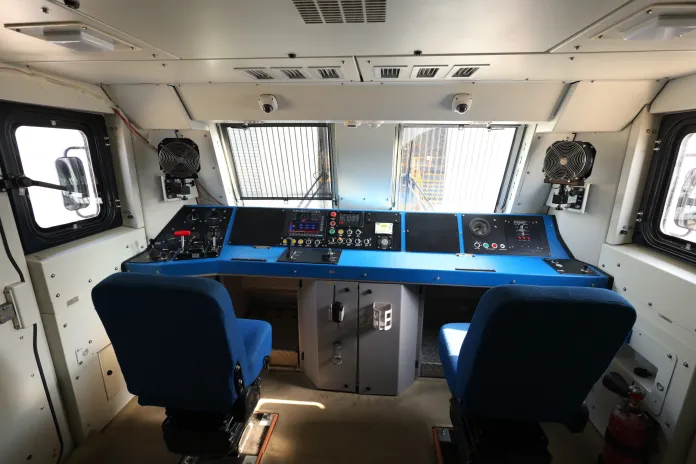Indian Railways has taken a major leap in freight mobility with the dedication of the Loco Manufacturing Shop at the Rolling Stock Workshop in Dahod, Gujarat by Hon’ble Prime Minister Shri Narendra Modi. This moment marked a pivotal milestone in the ongoing transformation of freight transport.
The facility, designed to produce 1,200 cutting-edge electric freight locomotives with a powerful 9000 HP capacity, stands as a testament to India’s engineering prowess and industrial ambition.
New era in freight transportation
At the dedication ceremony, the first electric locomotive from this workshop was ceremoniously flagged off, marking the dawn of a new era in freight transportation, one characterised by higher speeds, greater hauling power and a deep commitment to sustainability. With the ability to haul 4,500 to 5,000 tonnes even on steep gradients, these locomotives are set to be game-changers in heavy-duty freight movement.
Proudly built under the Make in India initiative, these locomotives are equipped with advanced IGBT-based propulsion technology, ensuring superior energy efficiency and operational performance. Together, these features position Indian Railways at the forefront of modern, reliable and eco-friendly freight logistics.
Power That Transforms Freight Logistics
The 9000 HP locomotive is the most powerful single-unit electric engine ever developed for Indian Railways. Until now, freight locomotives have typically operated at 4500 or 6000 HP capacities. While 12,000 HP engines do exist, they are created by coupling two 6000 HP units.
In contrast, the Dahod-built locomotive offers a unified, high-powered solution that can haul significantly longer and heavier freight trains with ease. This leap in capacity means fewer trips are needed for the same volume of goods, resulting in faster turnaround times, reduced congestion and improved freight efficiency.
Reducing Congestion, Lowering Costs
The increased hauling power of the 9000 HP locomotive offers a solution to one of Indian Railways’ biggest challenges: congestion on high-density freight routes. With fewer locomotives required to pull heavier loads, rail traffic can be optimised, thereby easing pressure on busy corridors.
Moreover, by replacing multiple smaller engines with one high-performance locomotive, Indian Railways stands to reduce operating costs, manpower requirements and energy consumption. These gains will ultimately translate into lower logistics costs for industries, contributing to more competitive pricing and streamlined supply chains.
Reviving Dahod: A Regional and National Asset
The decision to manufacture these advanced locomotives in Dahod is not just a strategic industrial move, it is a revival of the region’s railway heritage. Once a major hub for railway works, Dahod had seen a decline after key railway work was shifted elsewhere.
In 2022, Prime Minister Narendra Modi envisioned Dahod’s resurgence as a railway manufacturing powerhouse. Today, that vision has materialised with the setting up of a world-class facility in partnership with Siemens India, selected through a transparent tendering process.
The factory is equipped to produce both Broad Gauge locomotives for Indian Railways and Standard Gauge locomotives for export. This dual capability strengthens India’s positioning in the global rail manufacturing market. With 89% of the components made in India, the project aligns perfectly with the ‘Make in India’ and ‘Make for World’ visions. High-quality, cost-effective production makes these locomotives highly exportable, opening new doors for India in international railway supply chains.
Green Manufacturing, Cleaner Future
What sets the 9000 HP locomotive apart is its deep integration of sustainability. The manufacturing process itself is powered by green energy, earning the facility a Green Manufacturing tag.
The locomotive design includes regenerative braking, which feeds electricity back into the grid when brakes are applied, further reducing the carbon footprint. These features make the locomotive a strong contributor to India’s climate commitments and environmental goals, moving the nation closer to a greener future in transportation.
Safety, Comfort and Smart Engineering
From factory-fitted Kavach (India’s indigenous train collision avoidance system) to modern driver cabins with air-conditioning, low noise and minimal vibration, the 9000 HP engine is engineered with safety and comfort in mind.
Toilets feature electronic locks that can only be accessed when the engine is stationary, ensuring operational discipline. Onboard cameras on all sides provide enhanced monitoring and security.
Training for Tomorrow
A highlight of the Dahod facility is its focus on skill development through immersive training technology. A virtual digital model of the locomotive has been developed to enhance training for mechanics and drivers. Using VR headsets, trainees can interact with a highly realistic simulation of the locomotive, allowing them to explore and familiarise themselves with every component in a safe, immersive environment.
Employment, Empowerment, and Skill Development
Around 85% of the jobs created though the infrastructure development are held by local youth. Skill development is embedded into the project, with training modules designed to upgrade the technical capabilities of the workforce. The factory’s presence is already catalysing infrastructure development and ancillary industries in the region, driving long-term economic growth.
The 9000 HP locomotive will turn out to be the linchpin of a bold new freight ecosystem. Its power, efficiency and design sophistication promise to make Indian Railways more competitive, more sustainable and better equipped for future demands. By combining the strengths of technology, regional development and global vision, the Dahod-built locomotive is set to redefine the trajectory of freight transport, not just in India, but on the world stage.


